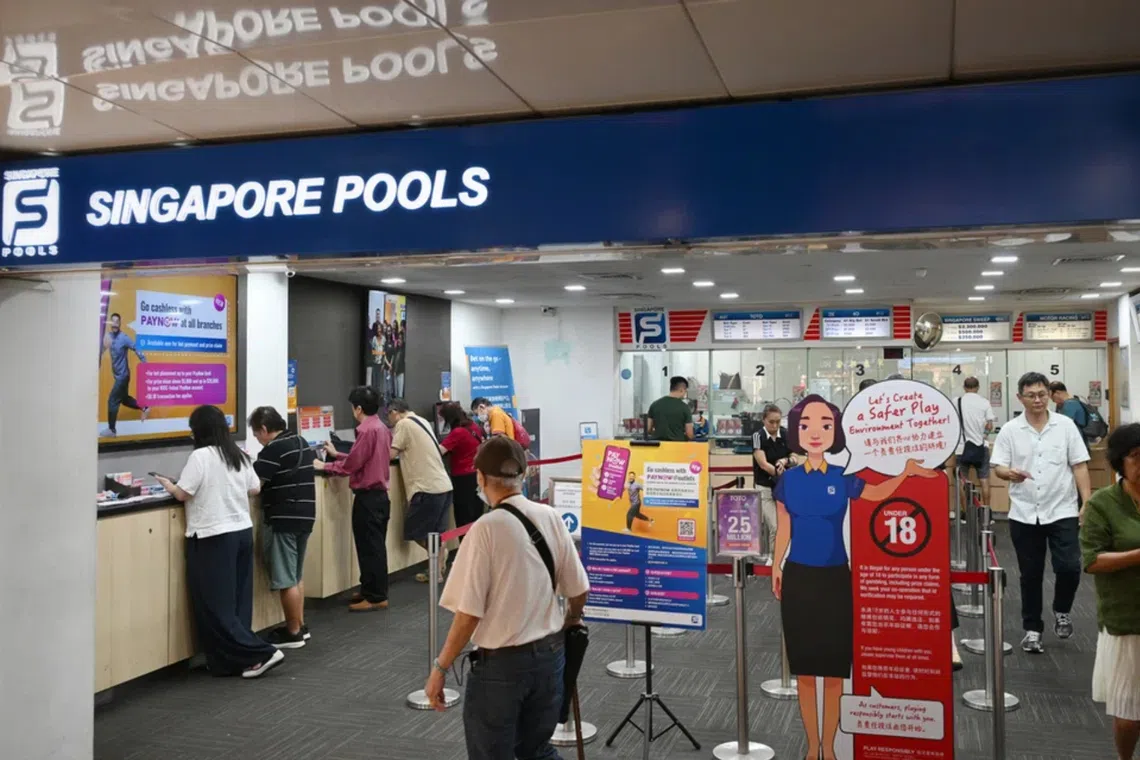Singapore Pools’ 10-cent PayNow fee under scrutiny; surcharges by merchants prohibited, says DPM Gan
Sign up now: Get ST's newsletters delivered to your inbox

The Association of Banks in Singapore is engaging Singapore Pools to address the practice of charging a 10-cent fee for each PayNow transaction.
ST PHOTO: KUA CHEE SIONG
Follow topic:
- Singapore Pools charges a 10-cent fee for each PayNow transaction, despite rules by the Association of Banks in Singapore (ABS) prohibiting surcharges by merchants.
- ABS is engaging Singapore Pools to address the PayNow surcharge, which existed before the March 2024 prohibition.
- Singapore Pools said all applicable fees are disclosed upfront to customers before they proceed with a transaction.
AI generated
SINGAPORE - PayNow merchants are not allowed to impose surcharges on customers for making such transactions.
But for years, Singapore Pools has been charging a 10-cent fee for each PayNow transaction.
Deputy Prime Minister Gan Kim Yong, who is also the Minister for Trade and Industry and chairman of the Monetary Authority of Singapore, said the Association of Banks in Singapore (ABS), which owns the PayNow scheme, is engaging Singapore Pools to address this practice.
DPM Gan revealed this in a written parliamentary reply on Oct 14 in response to a question by Mr Alex Yeo (Potong Pasir).
Mr Yeo had asked whether the Government was aware of any entities, including Singapore Pools, which are exempt from the rules prohibiting merchants from imposing surcharges for PayNow transactions.
DPM Gan said ABS has rules that prohibit merchants from imposing a surcharge on customers who wish to make payments via PayNow.
He added that transaction fees for payments received by merchants from end-consumers are waived by the major retail banks, while a minimal fee is charged if the merchant uses additional services like notifications for funds received.
He said there are more than 300,000 businesses in Singapore registered to use PayNow.
Singapore Pools is the only legalised sports, lottery and horse racing operator in Singapore. It is a subsidiary of the Tote Board, a statutory board of the Finance Ministry.
According to its website, the 10-cent fee applies for each PayNow transaction, including bet placement and prize claims.
The Straits Times had asked Singapore Pools for how long it had been collecting the 10-cent surcharge, how much was collected and if it intended to refund customers.
It did not address these questions, but its spokeswoman said the surcharge is not a new practice, having been introduced before the surcharge prohibition rules by ABS.
The ABS rules have been effective since March 2024.
The spokeswoman added: “All applicable fees are clearly disclosed upfront to customers before they proceed with a transaction, both through the Singapore Pools website and app.
“We have been working closely with our partner banks to review this arrangement in accordance with ABS regulations, while ensuring transaction security and reliability are not compromised.”
She said Singapore Pools has existing contracts with its partner banks that allow for the recovery of processing costs for payment transactions.
Singapore Pools generated $12.7 billion in turnover
This is the second issue relating to gambling fees to be highlighted in Parliament in just over a year.
The issue of entry levies collected by gambling operators was addressed in Parliament in 2024, when a lapse led to Singapore’s two casinos collecting $4.4 million more
To enter casinos here, Singapore citizens and permanent residents previously needed to pay a daily entry levy of $100 or an annual entry levy of $2,000.
The levies were raised to $150 and $3,000, respectively, on April 4, 2019, after the Casino Control (Variation of Entry Levies) Order 2019 came into effect.
This was valid for five years.
But the Ministry of Home Affairs overlooked its expiry date, leading to the casinos collecting higher entry levies than were permitted by law between April 4 and May 7, 2024.
MHA said it did not intend to refund any part of the entry levies collected during the lapse, as it was always its intention to continue with the higher entry levies until there was a need to further adjust the rates.


